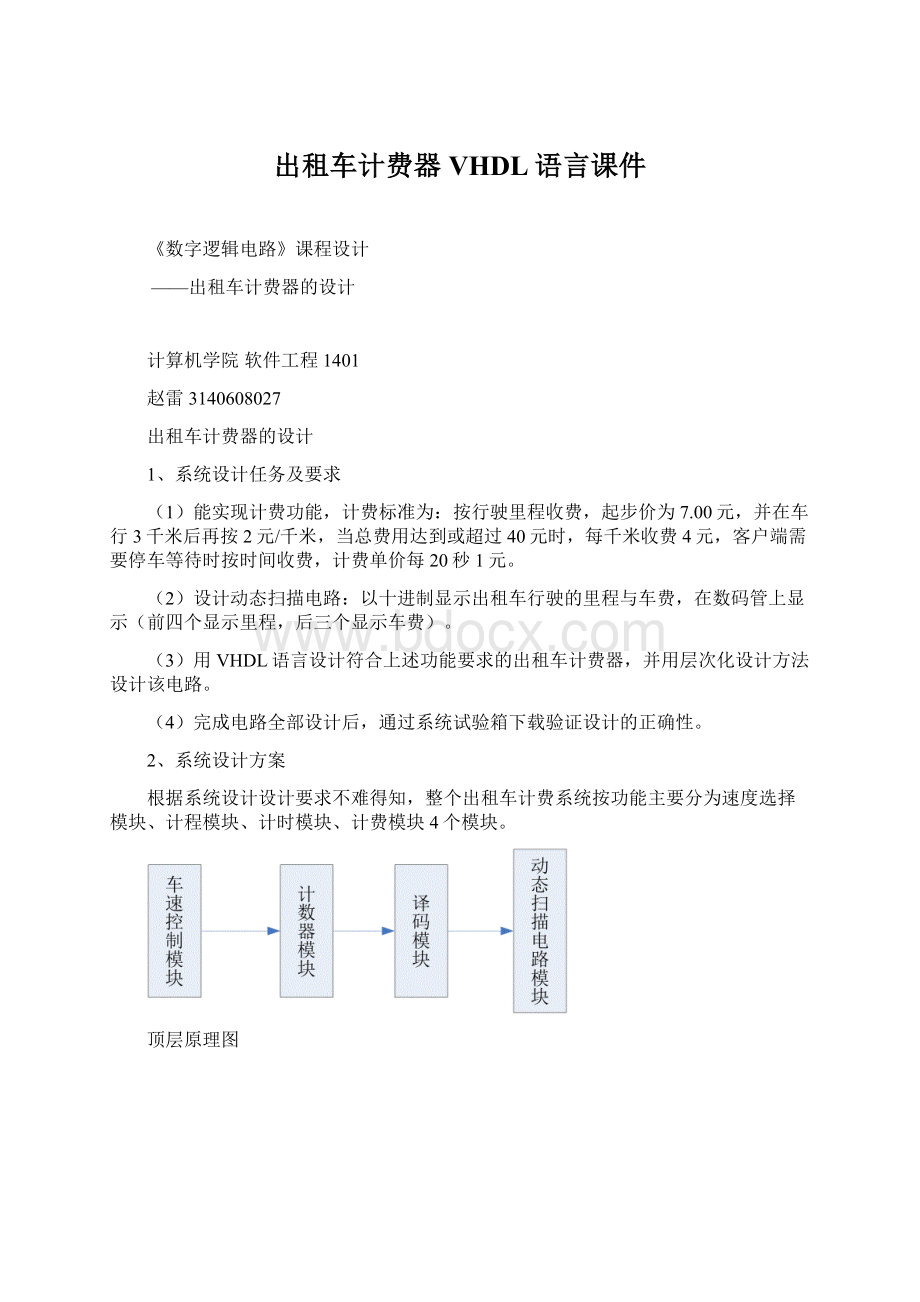出租车计费器VHDL语言课件.docx
《出租车计费器VHDL语言课件.docx》由会员分享,可在线阅读,更多相关《出租车计费器VHDL语言课件.docx(12页珍藏版)》请在冰豆网上搜索。

出租车计费器VHDL语言课件
《数字逻辑电路》课程设计
——出租车计费器的设计
计算机学院软件工程1401
赵雷3140608027
出租车计费器的设计
1、系统设计任务及要求
(1)能实现计费功能,计费标准为:
按行驶里程收费,起步价为7.00元,并在车行3千米后再按2元/千米,当总费用达到或超过40元时,每千米收费4元,客户端需要停车等待时按时间收费,计费单价每20秒1元。
(2)设计动态扫描电路:
以十进制显示出租车行驶的里程与车费,在数码管上显示(前四个显示里程,后三个显示车费)。
(3)用VHDL语言设计符合上述功能要求的出租车计费器,并用层次化设计方法设计该电路。
(4)完成电路全部设计后,通过系统试验箱下载验证设计的正确性。
2、系统设计方案
根据系统设计设计要求不难得知,整个出租车计费系统按功能主要分为速度选择模块、计程模块、计时模块、计费模块4个模块。
顶层原理图
1.速度模块:
通过对速度信号sp的判断,决定行使的路程,这里是通过速度信号来模拟一个变量的取值。
如kinside变量,其含义是行进100m所需的时钟周期数,然后每行进100m,则产生一个脉冲clkout来驱动计费模块。
VHDL语言:
libraryieee;
useieee.std_logic_1164.all;
useieee.std_logic_unsigned.all;
entityTaxi_part1is
port(clk,reset,start,stop:
instd_logic;
sp:
instd_logic_vector(2downto0);
clkout:
outstd_logic);
endTaxi_part1;
architecturebehaviorofTaxi_part1is
begin
process(clk,reset,stop,start,sp)
typestate_typeis(s0,s1);
variables_state:
state_type;
variablecnt:
integerrange0to1400;
variablekinside:
integerrange0to1400;
begin
casespis
when"000"=>kinside:
=0;
when"001"=>kinside:
=1400;
when"010"=>kinside:
=1200;
when"011"=>kinside:
=1000;
when"100"=>kinside:
=800;
when"101"=>kinside:
=600;
when"110"=>kinside:
=400;
when"111"=>kinside:
=200;
endcase;
if(reset='1')thens_state:
=s0;
elsif(clk'eventandclk='1')then
cases_stateis
whens0=>
cnt:
=0;clkout<='0';
if(start='1')thens_state:
=s1;
elses_state:
=s0;
endif;
whens1=>
clkout<='0';
if(stop='1')thens_state:
=s0;--相当于无客户上车
elsif(sp="000")thens_state:
=s1;---有客户上车,但车速位0,即客户刚上车还未起步
elsif(cnt=kinside)thencnt:
=0;clkout<='1';s_state:
=s1;
elsecnt:
=cnt+1;s_state:
=s1;
endif;
endcase;
endif;
endprocess;
endbehavior;
2.计程模块:
由于一个clkout信号代表行进100m,故通过对clkout计数,可以获得共行进的距离kmcount。
VHDL语言:
libraryieee;
useieee.std_logic_1164.all;
useieee.std_logic_unsigned.all;
entityTaxi_part2is
port(clkout,reset:
instd_logic;
kmcnt1:
outstd_logic_vector(3downto0);
kmcnt2:
outstd_logic_vector(3downto0);
kmcnt3:
outstd_logic_vector(3downto0));
endTaxi_part2;
architecturebehaviorofTaxi_part2is
begin
process(clkout,reset)
variablekm_reg:
std_logic_vector(11downto0);
begin
if(reset='1')thenkm_reg:
="000000000000";
elsif(clkout'eventandclkout='1')then--km_reg(3downto0)对应里程十分位
if(km_reg(3downto0)="1001")then
km_reg:
=km_reg+"0111";--十分位向个位的进位处理
elsekm_reg(3downto0):
=km_reg(3downto0)+"0001";
endif;
if(km_reg(7downto4)="1010")then
km_reg:
=km_reg+"01100000";--个位向十位的进位处理
endif;
endif;
kmcnt1<=km_reg(3downto0);
kmcnt2<=km_reg(7downto4);
kmcnt3<=km_reg(11downto8);
endprocess;
endbehavior;
3.计时模块:
在汽车启动时,当遇到顾客等人时,出租车采用计时收费的方式。
通过对速度信号sp的判断决定是否开始记录时间。
当stop=1时,不计费,当stop=0,sp=0时,开始按时间计费,当时间达到足够长时则产生Timecount脉冲,并重新计时。
一个Timecount脉冲相当于等待的时间达到了时间计费的长度。
使用1kHz的系统时钟,计算20s计数值为20000。
libraryieee;
useieee.std_logic_1164.all;
useieee.std_logic_unsigned.all;
entityTaxi_part3is
port(clk,reset,start,stop:
instd_logic;
sp:
instd_logic_vector(2downto0);
timecount:
outstd_logic);
endTaxi_part3;
architecturebehaviorofTaxi_part3is
begin
process(reset,clk,sp,stop,start)
typestate_typeis(t0,t1,t2);
variablet_state:
state_type;
variablewaittime:
integerrange0to1000;
begin
if(reset='1')thent_state:
=t0;
elsif(clk'eventandclk='1')then
caset_stateis
whent0=>
waittime:
=0;timecount<='0';
if(start='1')thent_state:
=t1;
elset_state:
=t0;
endif;
whent1=>
if(sp="000")thent_state:
=t2;
elsewaittime:
=0;t_state:
=t1;
endif;
whent2=>
waittime:
=waittime+1;
timecount<='0';
if(waittime=1000)then
timecount<='1';--20s,即1000个clk,产生一个时间计费脉冲
waittime:
=0;
elsif(stop='1')thent_state:
=t0;
elsif(sp="000")thent_state:
=t2;
elsetimecount<='0';t_state:
=t1;
endif;
endcase;
endif;
endprocess;
endbehavior;
4.计费模块:
计费模块由两个线程组成。
其中一个进程根据条件对Enable和Price赋值:
当记录的距离达到3千米后Enable变为1,开始进行每千米收费,当总费用大于40元后,则单价Price由原来的2元/千米变为4元/千米;第二个进程在每个时钟周期判断Timecount和Clkcount的值。
当其为1时,则在总费用上加上相应的费用。
VHDL语言:
libraryieee;
useieee.std_logic_1164.all;
useieee.std_logic_unsigned.all;
entityTaxi_part4is
port(clk,reset,timecount,clkout:
instd_logic;
kmcnt2:
instd_logic_vector(3downto0);
kmcnt3:
instd_logic_vector(3downto0);
count1:
outstd_logic_vector(3downto0);
count2:
outstd_logic_vector(3downto0);
count3:
outstd_logic_vector(3downto0));
endTaxi_part4;
architecturebehaviorofTaxi_part4is
signalcash:
std_logic_vector(11downto0);
signalPrice:
std_logic_vector(3downto0);
signalEnable:
std_logic;
begin
process(cash,kmcnt2)
begin
if(cash>="000001000000")thenprice<="0100";
elsePrice<="0010";
endif;
if((kmcnt2>="0011")or(kmcnt3>="0001"))thenEnable<='1';
elseEnable<='0';
endif;
endprocess;
kmmoney2:
process(reset,clkout,clk,Enable,Price,kmcnt2)
variablereg2:
std_logic_vector(11downto0);
variableclkout_cnt:
integerrange0to10;
begin
if(reset='1')thencash<="000000000111";--起步费用设为7元
elsif(clk'eventandclk='1')then
if(timecount='1')then--判断是否需要时间计费,每20s加一元
reg2:
=cash;
if(reg2(3downto0)+"0001">"1001")then
reg2(7downto0):
=reg2(7downto0)+"00000111";
if(reg2(7downto4)>"1001")then
cash<=reg2+"000001100000";
elsecash<=reg2;
endif;
elsecash<=reg2+"0001";
endif;
elsif(clkout='1'andEnable='1')then--里程计费
if(clkout_cnt=9)then
clkout_cnt:
=0;
reg2:
=cash;
if("0000"®2(3downto0)+price(3downto0)>"00001001")then
reg2(7downto0):
=reg2(7downto0)+"00000110"+price;
if(reg2(7downto4)>"1001")then
cash<=reg2+"000001100000";
elsecash<=reg2;
endif;
elsecash<=reg2+price;
endif;
elseclkout_cnt:
=clkout_cnt+1;
endif;
endif;
endif;
endprocess;
count1<=cash(3downto0);--总费用的个位
count2<=cash(7downto4);--总费用的十位
count3<=cash(11downto8);--总费用的百位
endbehavior;
5.显示模块:
时间的显示需要用到全部8个数码管,由于实验板上的所有数码管均对应同一组7段码,因此,需要采用动态扫描的方式实现时间显示。
VHDL语言:
libraryieee;
useieee.std_logic_1164.all;
useieee.std_logic_unsigned.all;
entitydisplayis
port(clk:
instd_logic;
kmcount1:
instd_logic_vector(3downto0);
kmcount2:
instd_logic_vector(3downto0);
kmcount3:
instd_logic_vector(3downto0);
count1:
instd_logic_vector(3downto0);
count2:
instd_logic_vector(3downto0);
count3:
instd_logic_vector(3downto0);
clkout:
outstd_logic_vector(6downto0);
sel:
bufferstd_logic_vector(2downto0));
enddisplay;
architecturedtsmofdisplayis
signalkey:
std_logic_vector(3downto0);
begin
process(clk)
variabledount:
std_logic_vector(2downto0):
="000";
begin
ifrising_edge(clk)then
ifdount="111"then
dount:
="000";
else
dount:
=dount+1;
endif;
endif;
sel<=dount;
endprocess;
process(sel)
begin
caseselis
when"000"=>key<=kmcount3(3downto0);
when"001"=>key<=kmcount2(3downto0);
when"011"=>key<=kmcount1(3downto0);
when"010"=>key<="1011";
when"101"=>key<=count3(3downto0);
when"110"=>key<=count2(3downto0);
when"111"=>key<=count1(3downto0);
when"100"=>key<="1010";
whenothers=>null;
endcase;
endprocess;
process(key)
begin
casekeyis
when"0000"=>clkout<="0111111";
when"0001"=>clkout<="0000110";
when"0010"=>clkout<="1011011";
when"0011"=>clkout<="1001111";
when"0100"=>clkout<="1100110";
when"0101"=>clkout<="1101101";
when"0110"=>clkout<="1111101";
when"0111"=>clkout<="0000111";
when"1000"=>clkout<="1111111";
when"1001"=>clkout<="1101111";
when"1010"=>clkout<="1000000";
when"1011"=>clkout<="1000000";
whenothers=>clkout<="1111111";
endcase;
endprocess;
enddtsm;